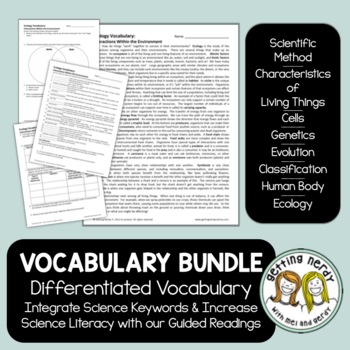Life Science Vocabulary Bundle - Differentiated Reading Passages & Questions
- Zip
- Google Apps™

Products in this Bundle (8)
showing 1-5 of 8 products
Description
Science terminology doesn't have to be overwhelming. Each of our integrated literacy activities includes a teacher-written, student-friendly reading that introduces new terminology in a fun and engaging way while providing differentiated options that can be given at the teacher's discretion. The readings are the same with minor adjustments, allowing students to feel successful and challenged at their level!
WHAT'S INCLUDED in this YEAR-LONG PRODUCT:
• Differentiated vocabulary lessons for each unit that include two levels:
☀ Below level readers, ESOL students, or those that require scaffolding: reading provides bold-faced terms, simple matching, guided extension questions
☀ Above level readers, honors, AP, or challenge students: reading provides regular type-face, graphic organizers provided for creating connections with terminology, rigorous and challenging extension questions
→ Cells and Cell Processes
→ Scientific Method and the Nature of Science
→ Genetics and Heredity
→ Evolution
→ Classification
→ Human Body Systems
→ Ecology and Ecosystems
• Answer keys
THIS PRODUCT IS ALSO FOUND IN OUR:
• Life Science Supplemental - Interactive Notebook, Word Wall, Task Card Bundle
CHECK OUT OUR OTHER LIFE SCIENCE PRODUCTS:
• Life Science Biology Curriculum Bundle
• Life Science Supplemental - Interactive Notebook, Word Wall, Task Card Bundle
• Life Science & Biology Interactive Notebook Bundle
• Life Science Centers / Lab Stations Bundle - Cross-curricular STEAM Activities
• Life Science Task Card Bundle
• Life Science Word Wall Bundle
SEE HOW THIS LESSON ALIGNS WITH THE NGSS, TEKS or GSE
Because we have created many of our own graphics or have purchased licenses to other graphics with permission, we cannot offer our resources in editable format unless otherwise stated.
TERMS OF USE (TOU):
All rights reserved by GETTING NERDY®️
• This product is to be used by the original purchaser only
• Intended for classroom and personal use only
• Copying for more than one teacher, classroom, department, school, or school system is prohibited
• This product may not be distributed or displayed digitally for public view
Failure to comply is a copyright infringement and a violation of the Digital Millennium Copyright Act (DMCA). Clipart and elements found in this PDF are copyrighted and cannot be extracted and used outside of this file without permission or license.
Life Science and Biology Vocabulary Bundle © 2012 to present Getting Nerdy ®️ All Rights Reserved





